A HORSE’S hoof may require a dressing to protect a wound over the coronet or heels, or help a foot abscess cavity to heal cleanly following opening and drainage. Bearing the horse’s weight means that foot wraps are more likely to slip or wear through than regular limb bandages, and the location is prone to contamination from dirt, muck and bedding. A variety of hoof boots and covers are available commercially but these can be expensive and may not be a good fit for every horse. Foot bandaging is therefore a useful skill to develop and an effective wrap can be fashioned out of a range of readily available materials (figure 1).
Before you get started, position the horse on a clean and non-slip surface in a well-lit area. The foot needs to be as clean and dry as possible. It may be useful to place a large clean towel or a few sheets of newspaper over the floor to avoid getting dirt on the foot if the horse accidentally sets it down.
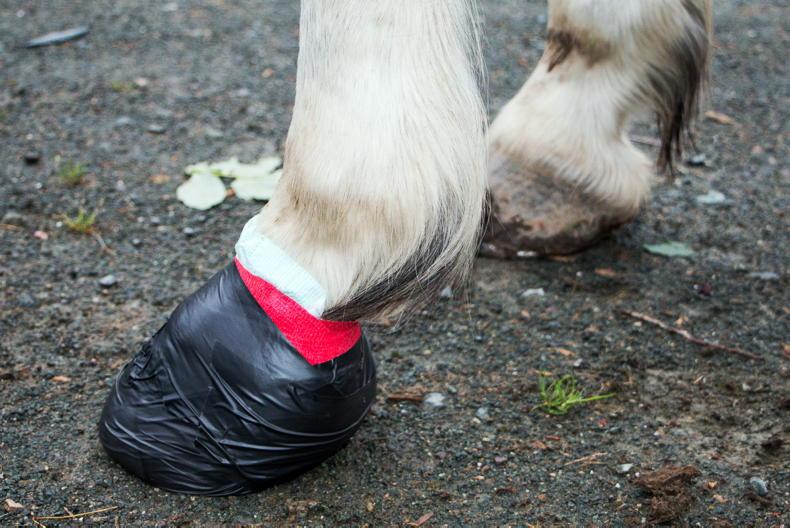
Medical bandages generally consist of three layers: the primary inner layer directly contacts the injury and typically consists of a dressing (for wounds) or a poultice. A secondary layer of padding provides support and soaks any moisture away from the injury, while the final outer layer holds everything in place and offers some protection.
The layers in a typical foot bandage consist of:
1. A sterile non-stick dressing for a wound or a poultice for abscesses. Commercial poultice dressings may be applied wet or dry, or a gauze swab soaked with a paste made from iodine and sugar (‘sugardine’) may be used. Conforming bandages are light and stretchy, and can be used to hold the dressing or poultice in place. Orthopaedic foam is another suitable material for this purpose – see figure 1.
2. A square of gamgee can be placed over the sole and wrapped up over the foot to act as padding. A disposable baby’s nappy is a useful alternative here as they are cheap, absorbent, readily available in a range of sizes and can be easily fastened in place around the pastern.
3. Cohesive bandage (that sticks only to itself e.g. ‘vetrap’) makes a suitable outer layer. Given that the horse will be standing on the bandage it’s helpful to reinforce this with a final outer layer of duct or silage tape. The tape has the additional advantage of being waterproof.
As with any wound care, wash and dry your hands thoroughly before you start (and repeat if they get dirty at any stage). Disposable gloves can be worn but they are not a substitute for clean hands. Personally, I find gloves to be more of a hinderance than a help when trying to manipulate bandages and tape and I prefer not to wear them for this task.

Contaminating
Open all the wrappers before you start to free up your hands and so you’re not going to frighten the horse with rustling plastic/paper. Place all your bandage materials in a tray or container to keep them clean and ensure they are within easy reach (figure 2). Pick the horse’s foot up – you can hold it between your knees if you need to have both hands free to work. Cover the injury with the dressing or poultice, taking care not to touch either the injury or the material that will be contacting it. This precaution avoids contaminating the area with dirt or bacteria. If you’re worried that the dressing might slip, e.g. down off an overreach injury, you can secure this first layer in place with a light conforming bandage or orthopaedic foam.
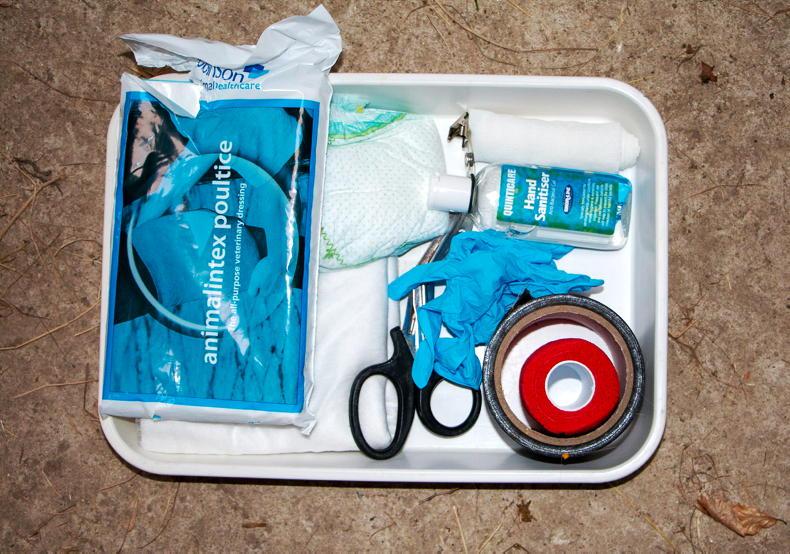
Next, secure the padding over the foot and wrap it with the cohesive bandage, tightly enough to keep everything in place (figure 3). Avoid having the bandage come too high up the limb and press on the skin – keep a bit of padding sticking out at the top. Finish by wrapping the sole and sides of the hoof with a layer of tape (figure 4). If you need to keep shavings etc. from making their way down into the bandage you can seal the top of it to the skin of the lower leg by wrapping it with some adhesive (sticky) bandage.
Some horses absolutely hate the sound of tape! – it may be helpful to pull a little off the roll at a distance and check their response. If the horse is startled, retreat out of earshot and cut 7-8 strips of tape, each about 12” long. Place these sticky side up with a slight overlap along the long sides, to form a square of tape. You can then stick this to your shirtfront to hold it until you’re ready to place it over the bottom of the bandage without frightening your patient.
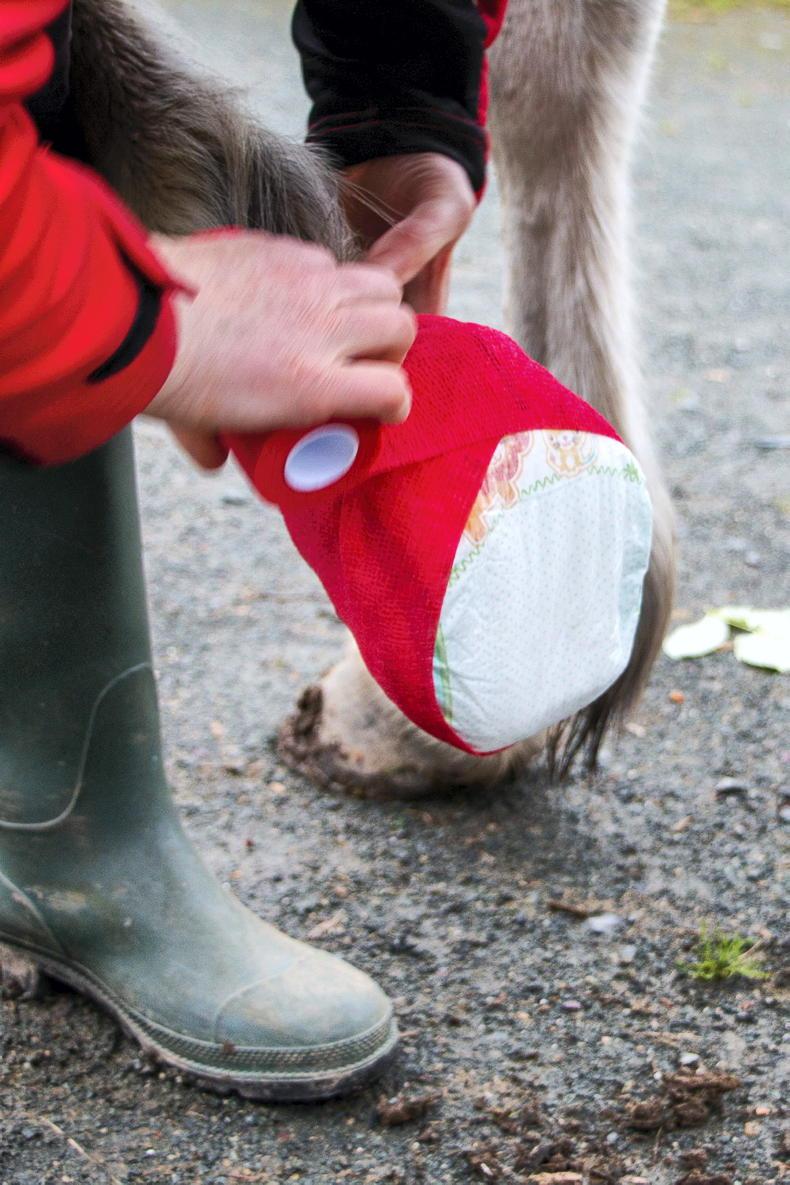
Poulticing
Generally, foot bandages are best changed daily, as they tend to wear through at the toe. This also allows regular inspection of the injury. For an uncomplicated foot abscess, replace the poultice with a dry dressing as soon as the injury stops discharging but keep the foot wrapped until the cavity seals.
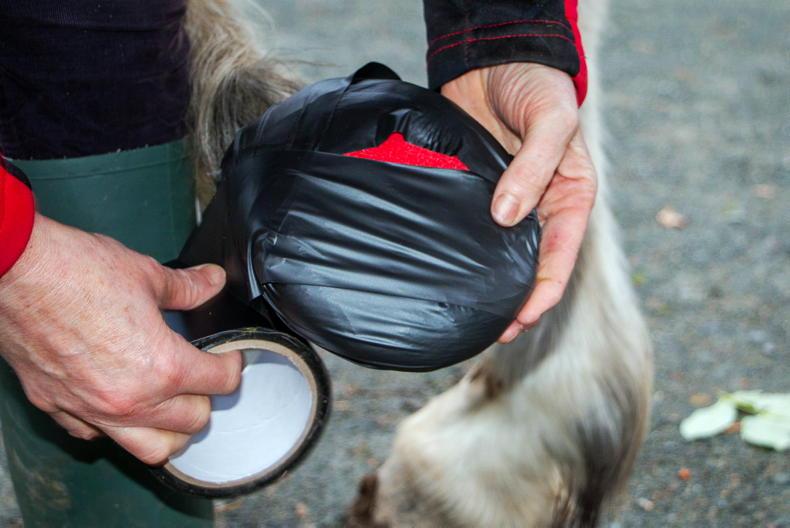
Avoid poulticing wounds on the heels or coronet, as this tends to promote the production of proud flesh and may actually delay healing. If in doubt, seek advice from your veterinary practice. While we’re all aware of the saying ’no foot, no horse’, it’s encouraging to note that the hoof has an excellent blood supply, and the majority of foot injuries heal uneventfully, especially when the risk of infection is reduced via an effective bandage.
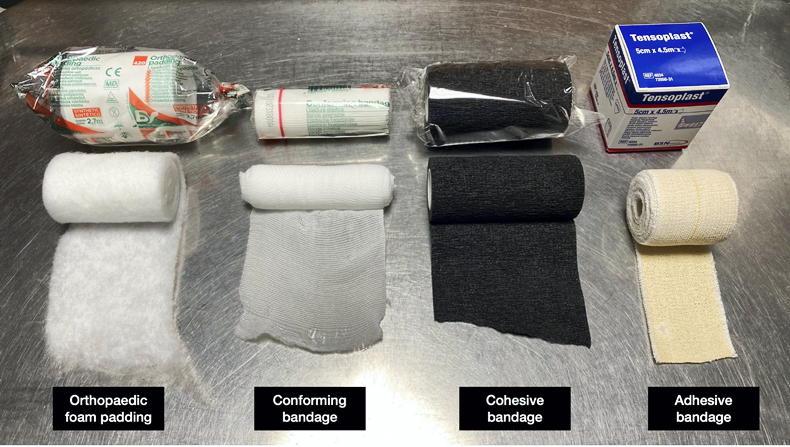



 This is a subscriber-only article
This is a subscriber-only article
 It looks like you're browsing in private mode
It looks like you're browsing in private mode









SHARING OPTIONS: